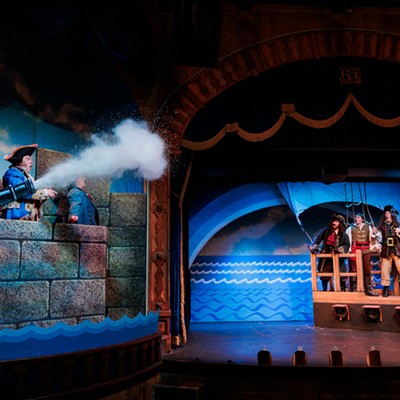Nothing could be further from the truth. Before tourists and the written language, hula was the way through which the Hawaiian people's histories, stories and spirituality were conveyed and celebrated. Slack Key guitar master Keola Beamer and his wife, hula dancer and teacher Moanalani Beamer, will offer "a window into Hawaiian folklore" with a performance at 8 p.m. Friday, Sept. 17 at the Berger Performing Arts Center. The performance will combine mele (song), hula (dance) and oli (chant), art forms in which the families of both Keola and Moanalani have a long, long history.
Keola Beamer's family traces their roots to 15th-ccentury Hawaii--his great-grandmother, Helen Desha Beamer, was a celebrated and prolific singer-songwriter, whose compositions often came to her in dreams; his mother, Winona Kapuailohia Beamer, is a noted chanter, composer and author, who has spent a lifetime researching and teaching "Hawaiiana," a term she reportedly coined. All that history made Keola Beamer willing and able to combat what he called "a shallow stereotype (of Hawaiians), often demeaning to the native culture."
Though a child of the rock 'n' roll era, Beamer was one of the first Hawaiian recording artists to integrate Hawaiian chants and instruments into his music--instruments such as the tiny gourd whistle and nose flute. His CD Honolulu City Lights has sold more copies than any other album in the history of Hawaiian music, and since the mid-'90s, all of his releases have reached the top of the Billboard World Music Chart. He's won numerous Hoku awards (the equivalent of a Grammy), has appeared on both Sesame Street and the Today Show, and--you're probably expecting this--has a fondness for haikus about Spam. ("And who dares mock Spam?/You? You? You are not worthy/of one rich pink fleck.")
It doesn't stop there. The man with a tendency to write letters to the Big Island mayor (while posing as a skate-boarding, ferret-owning kid who wants to change the name of the city of Hilo to Gi-lo) also offers this priceless collection of handy Hawaiian phrases for use while traveling, staying in hotels and eating out: "Kahaha ko'u na'au I ke åano o ka mea åai ma kei mokulele" (I am filled with admiration for my in-flight meal); "He lumi maika'I keia e ku pololei ana I ke kanaka peke" (This is a wonderful room for a dwarf); "He kanapapiki mahalo åole keia mea inu Merlot ia'u" (This Merlot is an ungrateful bitch).
Humor aside, both Beamers take the preservation of their art forms seriously; like most of the music, dance and language of native people all over the world, there was a time during which white missionaries tried to take it away from them. Hula, for example, was deemed "noisy" and "heathenish" by Christian missionaries who arrived in Hawaii in 1820, and with the support of high-ranking chiefs who had been converted, they managed to get it banned.
Hula continued to be taught and practiced secretly throughout the 19th century, and with the 1874-1897 reign of King David Kalkaua (also spelled Kalakaua), it was brought back to the royal court. "Hula," he reportedly said, "is the language of the heart and therefore the heartbeat of the Hawaiian people." Kalkaua gathered experts in traditional Hawaiian arts and encouraged them to practice publicly again, despite the objections of Christianized Hawaiians and non-Hawaiians. It was during this time, according to the International Encyclopedia of Dance, that hula practitioners merged poetry, chanted vocal performance, dance movements and costumes into a new form, called hula ku'i, which translates into "to combine old and new." Concessions were made to the tourist industry in the 1930s and '40s (English-language lyrics, sex appeal through emphasized hip movements, the removal of hula from its former religious context), but a resurgent interest in the pre-ku'i form of hula showed up in the early 1970s, and many forms of hula are alive and well today.
The term hula refers to movement and gestures, but hula cannot be performed without mele (poetry)--a record of cultural information that contains prayers, love songs, songs that praise the land and name chants--and percussive instruments such as the 'uli'uli (feather-decorated gourd rattle), pu'ili (split bamboo rattle), 'ili'ili (waterworn stone pebbles, two in each hand) and kala'aj (sticks). If you're looking for an expert in all of these forms, look no farther than Moanalani Beamer, who began her hula training at the age of four with Kuma Hula (hula master) Johnny Hokaona. She made her professional debut at fancy hotels and resorts on the island of Maui, but is committed to sharing her knowledge of Hawaiian culture with the rest of the world, and now travels regularly to Europe, Japan and the United States performing with her husband and teaching hula workshops.
Tucsonans who want to learn hula will get one chance only: At 10 a.m. Saturday, Sept. 18, Moanalani will teach a two-hour beginning- and intermediate-level workshop in Kahiko and Auwana hula at The Muse (516 N. Fifth Ave.); call 891-6555 for workshop information.
For tickets to the Beamers' performance at the Berger Performing Arts Center ($19-$23), call 297-9133.







